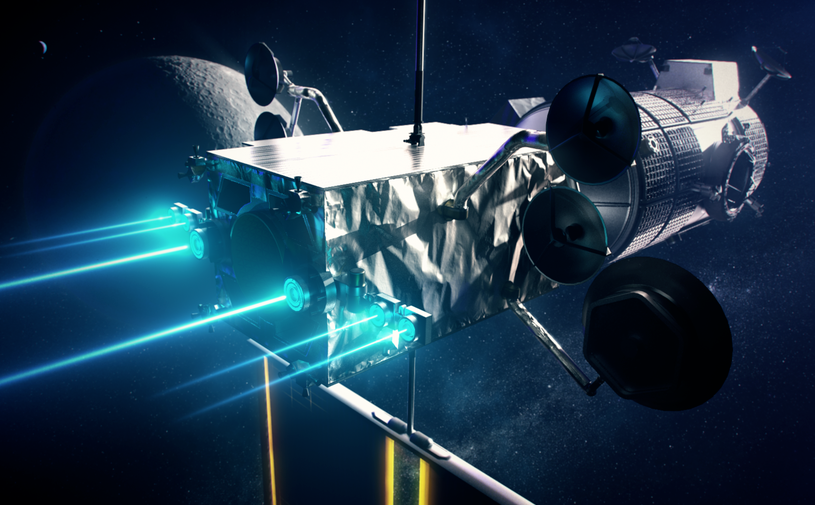NASA’s Latest Rocket Propulsion Systems for Deep Space Journeys
NASA has been hard at work for decades developing new rocket propulsion systems for future crewed missions to Mars and beyond. The overarching goal of these novel propulsion systems is to produce more thrust from less fuel.
If achieved, such goals mean that less fuel is necessary to make longer journeys at dramatically higher speeds. Some reports indicate that what many had assumed would be a 6-month journey to Mars may possibly take place in less than 45 days. Once more, the need to carry less fuel allows for more room for crew and scientific equipment.
Some 60 years ago, the space agency began discussing what it calls “nuclear thermal propulsion systems.” This technology involves using a mild fission reactor to generate heat that’s then used to rapidly heat a liquid hydrogen propellant. The heat causes the hydrogen to expand at insanely high rates, thus creating much higher thrust than current rocket engines.
Another version of NASA’s nuclear propulsion systems involves some different technology. In its nuclear electric propulsion system, rather than using nuclear power to generate heat, it’s used to generate electricity. This power is then used to ionize krypton or xenon gas – rip off the electrons so they have a positive charge – and then using magnetic and/or electric fields to accelerate these ions out nozzles in the back of the rocket. Rather than seeing the typical fire from rocket engines, these Hall Effect Thrusters actually glow bright green. How cool is that!
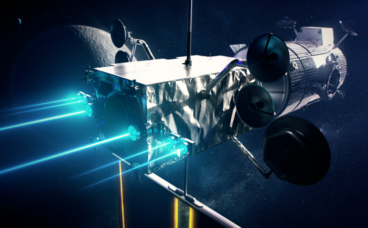
In a final spin on the next generation rocket engines, NASA is researching what are called rotating detonation engines.
Okay, there’s a lot of deep complexity in how these engines function, but to simplify, this technology relies on detonating fuel rather than combusting it. As anyone knows from watching the MythBusters, detonation is a much higher velocity and a much more violent event than combustion. NASA has found a way of using a chain reaction of detonations to create a highly efficient self-sustaining way of generating thrust out of a rocket engine.
In January, NASA ran a successful test of a rotation detonation engine producing 4,000 pounds of thrust. It has plans in the upcoming months to test a similar engine producing 10,000 pounds of thrust.
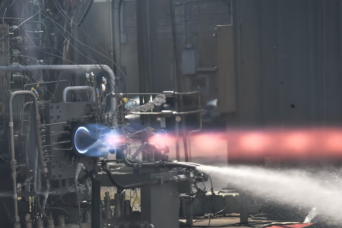
Other US government agencies, especially the military, are also researching rotating detonation engines.
The Business of Artificial Satellites
The total tonnage of satellites orbiting the Earth has grown dramatically in recent years (see graph below). Some estimate that on a pound for pound basis, there were more satellites launched into orbit in 2020 and 2021 than had been launched in total from 2009 until 2020.
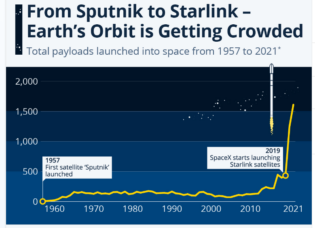
The steepest climb on this graph is not surprisingly associated with SpaceX. This effort aims to provide continuous internet access for the entire globe.
In total, SpaceX plans on placing 12,000 small satellites in low-Earth orbit by 2025. The program budget is $10 billion USD. Starlink plans to offset this investment by selling satellite internet services to customers. By the end of 2022, Starlink reported already having 1 million active subscribers. Perhaps most important, the company projects that revenues will reach more than $30 billion USD by 2025.
In terms of yearly revenue, the world’s biggest satellite companies are far from household names, like Luxemburg’s SES. The company mainly provides digital connectivity services to governments and other institutions, and it’s expected to generate about $2.5 billion in 2023.
Another company in the top ten of satellite space include the US’ Intelsat, which provides satellite communications services to the US government. Interestingly, the company was founded by the Kennedy administration in the early 1960s, and it provided the video feed from the Appollo Moon missions that people watched on TV in 1969.
As a final example of a top player in the satellite space, consider Australia’s Speedcast, which generated over $1.9 billion USD in 2021.
The graph below shows the true size and projected size of the satellite business through 2028.

Satellite Launches: A True MegaTrend
Advances in 3D printing technology promise to bring more and more newcomers to the satellite business. Never has it been so easy to produce the hardware of a satellite than now. So, the market is expected to continue to expand for decades to come. That’s why launching satellites and collecting revenues from the services they provide is a true MegaTrend for all the players involved.
Bear in mind that in the early stages of this MegaTrend, the best of the innovative big companies show the most long-term promise. They’ve proven their reliability and practicality on numerous missions and will endure where smaller companies that operate in a single niche may not be able to adapt or grow as the sector expands.
A Stocks & Options Portfolio with Massive Gains
Have you planned out your financial goals for 2023? It’s not too late! This year can be the year that you give yourself and your family the gift of generational wealth.
Our subscribers of Proffe’s Trend Portfolio 2.0 are experiencing massive gains. The graph below shows the profit that was made after our first Proffe’s Trend Portfolio option sell – 36% profit in just 2 months!
This is one example of the growth we’ve seen happen to our overall Trend Portfolio in just a few short months and shows how advantageous following our unique options strategy can be by turbocharging gains.
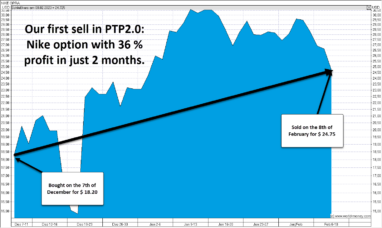
| Don’t miss out on these spectacular gains – start your 14-day trial today for just $1 and experience the excitement of successful investments! Start Your 14-Day Trial for $1 |
